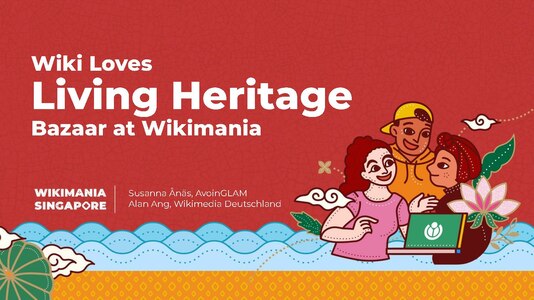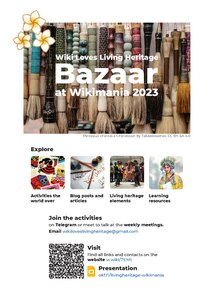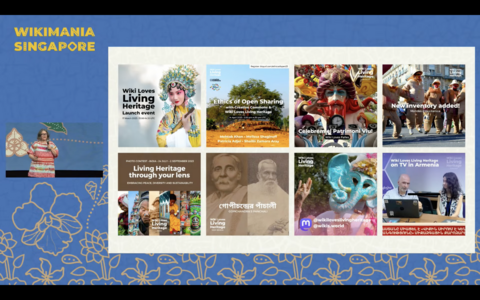GLAM/Newsletter/August 2023/Contents/Wiki Loves Living Heritage report
|
Looking back, looking ahead
-
Located in a historic building erected in 1915, the Tekka Centre Wet Market is home to nearly 300 food stalls. Wet markets represent a rich part of Singapore’s history and food culture, being a primary place where people gather and get their daily essentials. Photo by Kari.Shouur, CC BY-SA 4.0.
-
From September until early October, the Nine Gods Festival comes to temples across Singapore. In the finale of the festival, devotees tug paper boats into the sea and set them alight. Photo by Rodney Ee, CC BY-SA 4.0.
-
A woman wanders through a market on Arab Street in downtown Singapore, admiring colorful Turkish lamps. Photo by Henry Vante, CC BY-SA 4.0.
Wiki Loves Living Heritage at Wikimania
Page: https://w.wiki/7EMt
The photo contest
The photo contest Wiki Loves Living Heritage in Singapore was fantastically featured as a key event at Wikimania. The contest produced an impressive amount of 1,180 images. The partners, the National Heritage Board of Singapore and the National Youth Achievement Award, extended their collaboration to several areas of the program. The young volunteers from NYAA offered their invaluable help throughout the conference.
The winners of the photo contest were awarded in the closing ceremony. The photo contest was featured in the Diff blog by the Wikimedia Foundation.
Presentations
On the second day, the program in the plenary was opened by a keynote from Dr. Kirk Siang Yeo from the National Heritage Board. He presented the activities the Singapore Heritage Board is taking to safeguard Living Heritage in the country.
It was followed by the overall presentation of the Wiki Loves Living Heritage program by Susanna Ånäs and Alan Ang.-
The flyer shared at Wikimania
-
Watch the video at YouTube
Hackathon
We also proposed Hacking ideas for hacking at the hackathon. They are still valid, pick your choice!
Coming up
In the latter part of the year, we will be looking back as well as forward, beyond the festive year by featuring more local activities, making introductions to living heritage at events, facilitating data imports and sharing experiences in the blog.

|
The Wiki Loves Safeguarding Living Heritage in Europe contest will be ending in September. Hurry up to be part of it!
|
Explore Wiki Loves Living Heritage
See pages for heritage elements on the UNESCO Lists and registers of Intangible Cultural Heritage, the locally maintained inventories as well as country pages that feature all of these plus elements that have been nominated by the editors.
- See the page Elements on UNESCO Lists and its subpages to view the heritage elements that have been inscribed in the UNESCO Lists and Registers of Intangible Cultural Heritage.
- See the page Inventories for a list of all recorded inventories. You can view the elements of an inventory by clicking on the button below the image if elements have been added to Wikidata and if the page has been created.
- The countries page links to pages that collect all the different types of items together by country: Elements on UNESCO Lists and Registers, in locally maintained inventories as well as elements that anyone has wished to include in the Wiki Loves Living Heritage projects. Check out below how to add your favourite heritage element.
Things you can do

|
Write a blog post!We are vitalizing the Wiki Loves Living Heritage blog in the coming months. If you have an interesting concept for a project, an important perspective, or would like to share your experiences working with living heritage, drop us a line at wikiloveslivingheritage@gmail.com. |

|
Add your inventoryIf you are interested in facilitating the import of the heritage elements from your country to Wikidata, there will be many online opportunities to learn about that during the autumn. Here's a quick outline of the process to get you started right away.
|

|
Add your favorite heritage element to Wiki Loves Living Heritage pagesRegardless of whether your favorite festival or local snack is included in an inventory or not, or if the inventory is not added to Wikidata yet, you can add any living heritage element to the project yourself.
|

|
Add translations and imagesAt the end of each inventory or country page, you find grey boxes with tasks that you can do. Choose the simple tasks to translate inventory or heritage element names and descriptions to you language and to add missing images. |

|
Make contacts locallyTo get started with local collaborations between authorities and Wikimedia affiliates, start by browsing the directory of Contacts. You can also plan to arrange a Bazaar, a meeting in your country or region. |
Wiki Loves Living Heritage is initiated jointly between the European network of focal points for the UNESCO 2003 Convention (ENFP) and AvoinGLAM.
- Albania report
- Argentina report
- Armenia report
- Belgium report
- Brazil report
- Canada report
- Germany report
- Italy report
- Kosovo report
- New Zealand report
- Poland report
- Serbia report
- Sweden report
- Switzerland report
- UK report
- USA report
- AvoinGLAM report
- Content Partnerships Hub report
- Structured Data on Wikimedia Commons report
- Wiki Loves Living Heritage report
- WREN at Wikimania report
- Calendar









